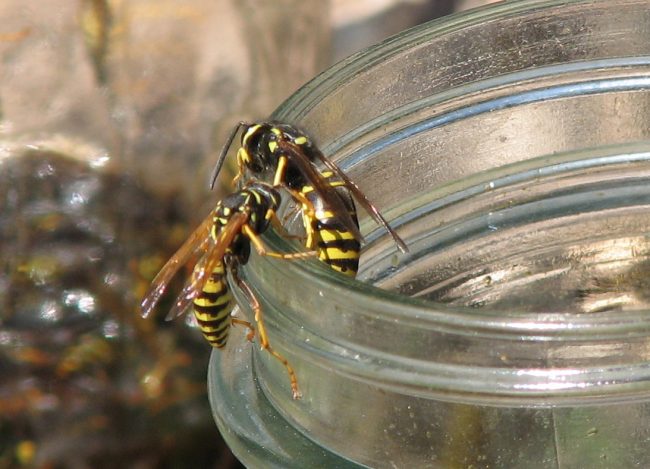by Vijai Pandian, Horticulture Extension Educator
Wasps often have a scary reputation because of their painful sting, but they are highly beneficial insects in the ecosystem. They prey on many flies, caterpillars, and young insects that damage crop plants, and to a certain extent they also help in pollination. Yellowjackets and paper wasps are two common groups of wasp species in Wisconsin that tend to become a nuisance in urban areas from late summer to mid-fall. Bald-faced hornets are often mistaken as true hornets, but they are a type of yellowjacket.
Yellowjackets and paper wasps are social insects where the queen dominates the colony. Their nests are built of papery pulp materials from chewed wood fiber mixed in with their saliva. Paper wasps commonly build their nest on the eaves of buildings, barns, overhangs, and on tree limbs. Their simple looking nest consists of a single layer comb resembling an umbrella shape and does not have any protective casing around it. Yellowjackets and bald hornets have multiple layers of stacked round combs covered with layers of papery sleeves. Often, yellow jacket nests are found in old rodent burrows, cavities, and wall voids, and bald hornet nests are commonly found in trees.
In August, the wasp population peaks up and they actively scavenge foods rich in sweets and carbohydrates which naturally draw them to picnic spots, gardens, and outdoor cookout areas in search of juices and leftover foods in garbage cans, trash bags, and around overripe fruits. Scavenging wasps are tough to control, however you can try to minimize their attention by following good sanitation practices in the outdoors. Place all food, garbage, and empty beverage cans in containers with tight-fitting lids. Check your open food and drink for any signs of wasps before you consume it. Harvest overripe fruits like grapes, apples, and raspberries early in the morning when wasps are less active. Dispose of any rotten fruits and vegetables from the garden areas.
It is not necessary to remove wasp nests that are far from human activities. If you detect a wasp nest near your home or in a high traffic area, then it is wise to remove the nest. The best time to remove the wasp nest is during late evening or at night when they remain less active. For safety, wear a long-sleeved shirt, long pants with the legs cuffed with rubber bands or tape, boots, rubber/leather gloves, and a beekeeper’s hat and veil. To remove exposed wasp nests hanging on trees or eaves, use a ready to use aerosol spray for “wasps and hornets.” Repeat the application at a three-day interval if you happen to notice the wasp activity again. When spraying, do not flash the light directly at the nest, as it can agitate the wasps and draw them towards the light. On a ground nest, dust the entrance using Sevin and observe for any activities over the next few days. If no signs of wasps are visible, then cover the nest entrance with soil. Always read the product label and follow its directions. Nests built in concealed areas such as in wall voids, attics, or in tight spaces are tough to control. In those scenarios, it is best to seek help from professional pest control companies. To find a list of professional pest control companies in your area, visit the Wisconsin Pest Control Association website.
For more gardening info or plant health-related questions, contact us at panthealth.advisors@extension.wisc.edu





